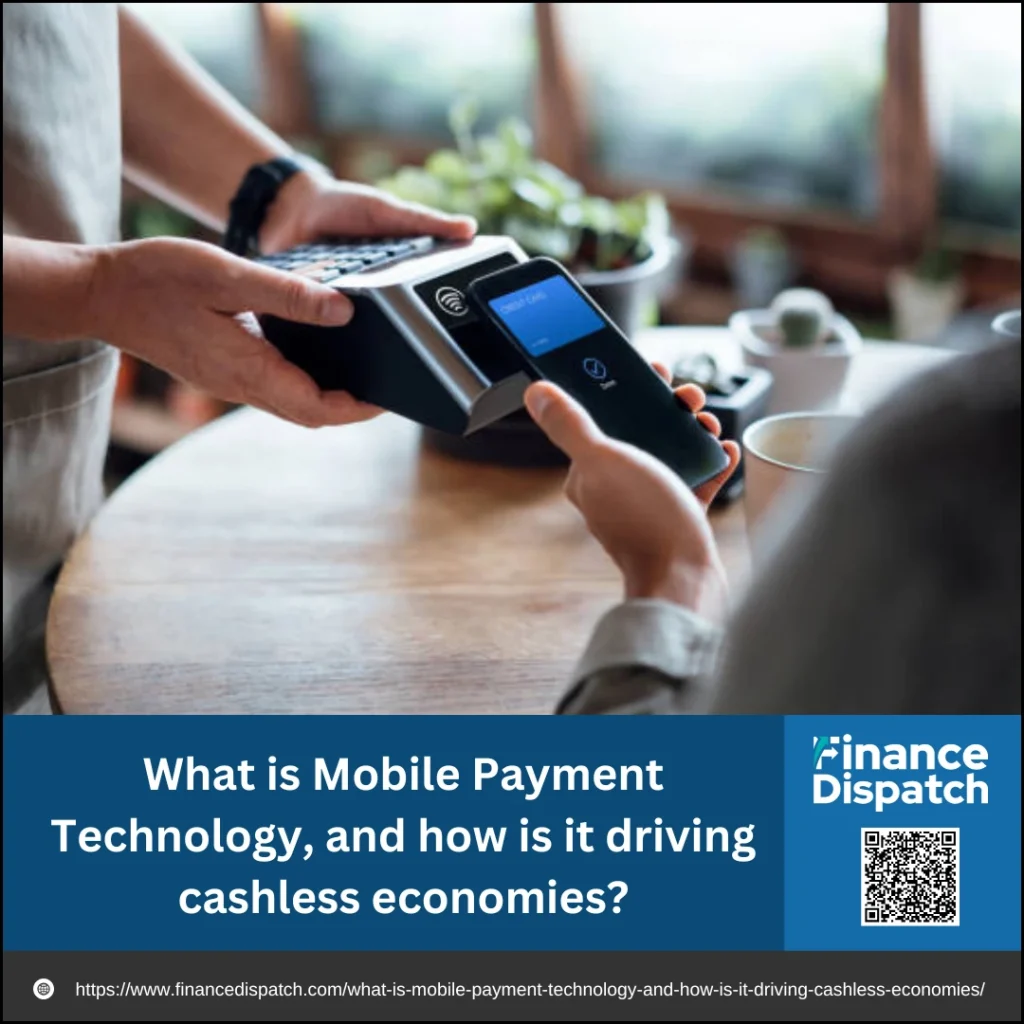Imagine a world where you no longer need to carry cash or even a physical credit card—where a simple tap, scan, or click on your smartphone is enough to complete any transaction. This is the reality brought by mobile payment technology, a digital revolution that is transforming how people pay for goods and services. From NFC-enabled contactless payments to QR code scans and digital wallets, mobile payment systems offer speed, convenience, and security, making cashless transactions the new norm. As businesses and consumers increasingly adopt these technologies, cash is slowly becoming obsolete, paving the way for fully cashless economies. But how exactly does mobile payment technology work, and why is it gaining momentum worldwide? In this article, we’ll explore the fundamentals of mobile payment systems, their impact on the global economy, and the challenges and opportunities they present in the journey toward a digital financial future.
What is Mobile Payment Technology?
Mobile payment technology refers to digital transactions conducted using smartphones, tablets, or other mobile devices, eliminating the need for cash or physical cards. It enables users to make purchases, transfer money, and pay bills securely through various methods, such as Near-Field Communication (NFC), Quick Response (QR) codes, Bluetooth, and mobile banking apps. Services like Apple Pay, Google Pay, Samsung Pay, and digital wallets store payment credentials securely, allowing users to complete transactions with just a tap or scan. This technology enhances convenience, security, and financial inclusion, making digital payments accessible even to those without traditional banking services. With the rapid rise of mobile commerce and fintech innovations, mobile payment systems are driving a shift toward a cashless, digitally connected economy.
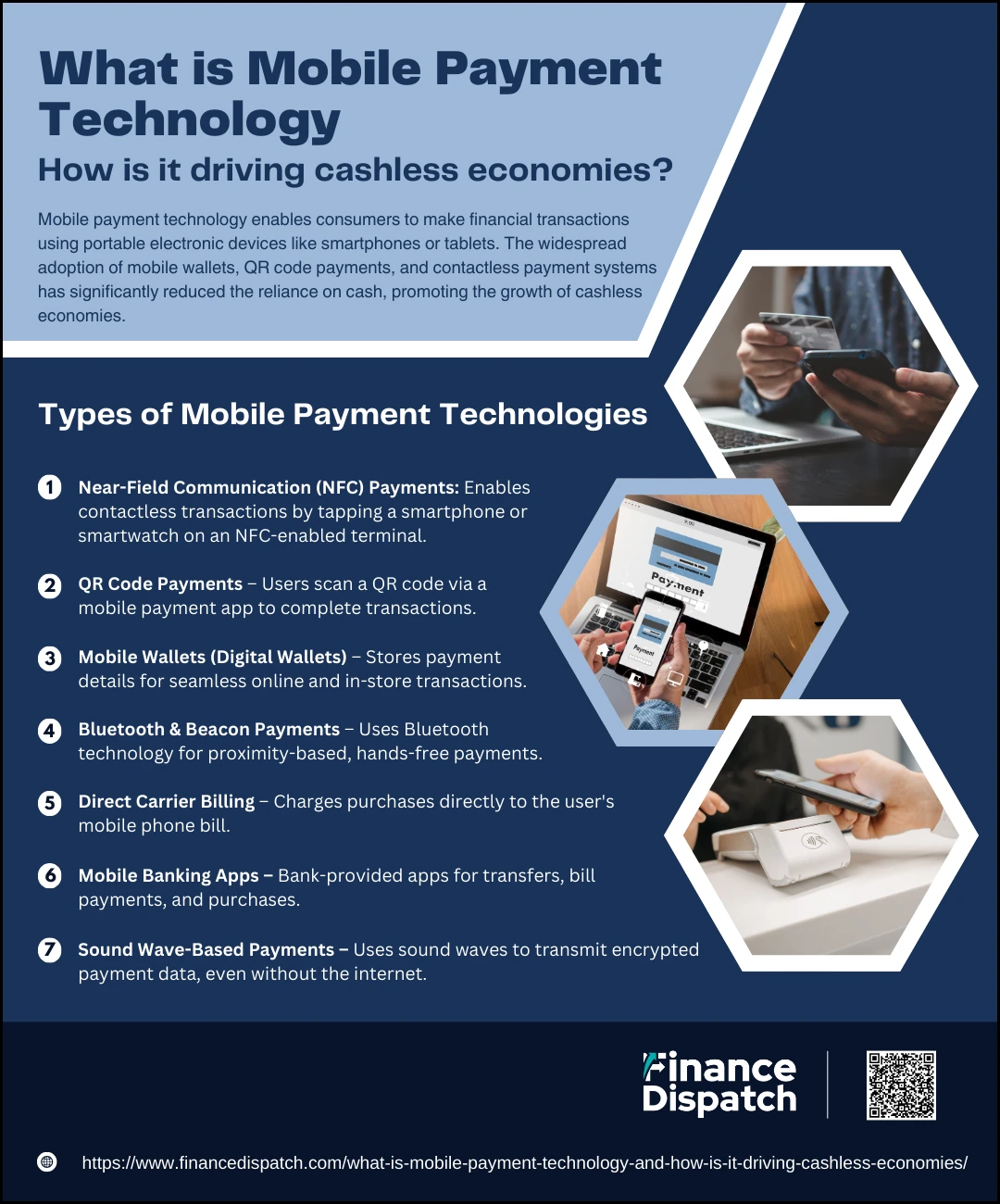 Types of Mobile Payment Technologies
Types of Mobile Payment Technologies
As digital transactions become more prevalent, mobile payment technologies have revolutionized the way people pay for goods and services. These technologies offer speed, security, and convenience, reducing reliance on cash and traditional card-based payments. Whether through tap-and-pay systems, QR codes, or mobile wallets, businesses and consumers are embracing digital payment methods that simplify transactions. Below are the major types of mobile payment technologies reshaping financial transactions worldwide.
1. Near-Field Communication (NFC) Payments
NFC allows two devices to exchange data when they are within a few centimeters of each other. This is commonly used in contactless payment systems such as Apple Pay, Google Pay, and Samsung Pay, enabling users to tap their smartphones or smartwatches at NFC-enabled terminals to complete transactions securely.
2. QR Code Payments
A popular method in markets like China and India, QR code payments require users to scan a merchant’s QR code using a mobile payment app (e.g., WeChat Pay, Alipay). Alternatively, customers can generate a QR code on their devices for merchants to scan, facilitating seamless transactions without cash or cards.
3. Mobile Wallets (Digital Wallets)
Mobile wallets store credit card, debit card, or bank account details securely, allowing users to make in-store and online payments with ease. Examples include PayPal, Apple Wallet, Google Wallet, and Venmo, which support peer-to-peer transfers, bill payments, and retail purchases.
4. Bluetooth & Beacon Payments
This technology enables hands-free, proximity-based transactions through Bluetooth-enabled payment terminals. Businesses can detect a user’s device and process payments automatically, enhancing customer convenience. While not as common as NFC or QR codes, this method is used in some retail and event payment systems.
5. Direct Carrier Billing
With direct carrier billing, users can charge purchases directly to their mobile phone bills, eliminating the need for a bank account or credit card. This is commonly used for app purchases, digital subscriptions, and online gaming services.
6. Mobile Banking Apps
Many banks provide mobile apps that allow users to transfer money, pay bills, and make purchases directly from their accounts. These apps often integrate with mobile wallets, providing a secure and centralized payment solution for customers.
7. Sound Wave-Based Payments
This lesser-known method transmits encrypted payment data using sound waves to complete transactions. The technology allows feature phones (non-smartphones) to make mobile payments without an internet connection, making it useful in regions with limited connectivity.
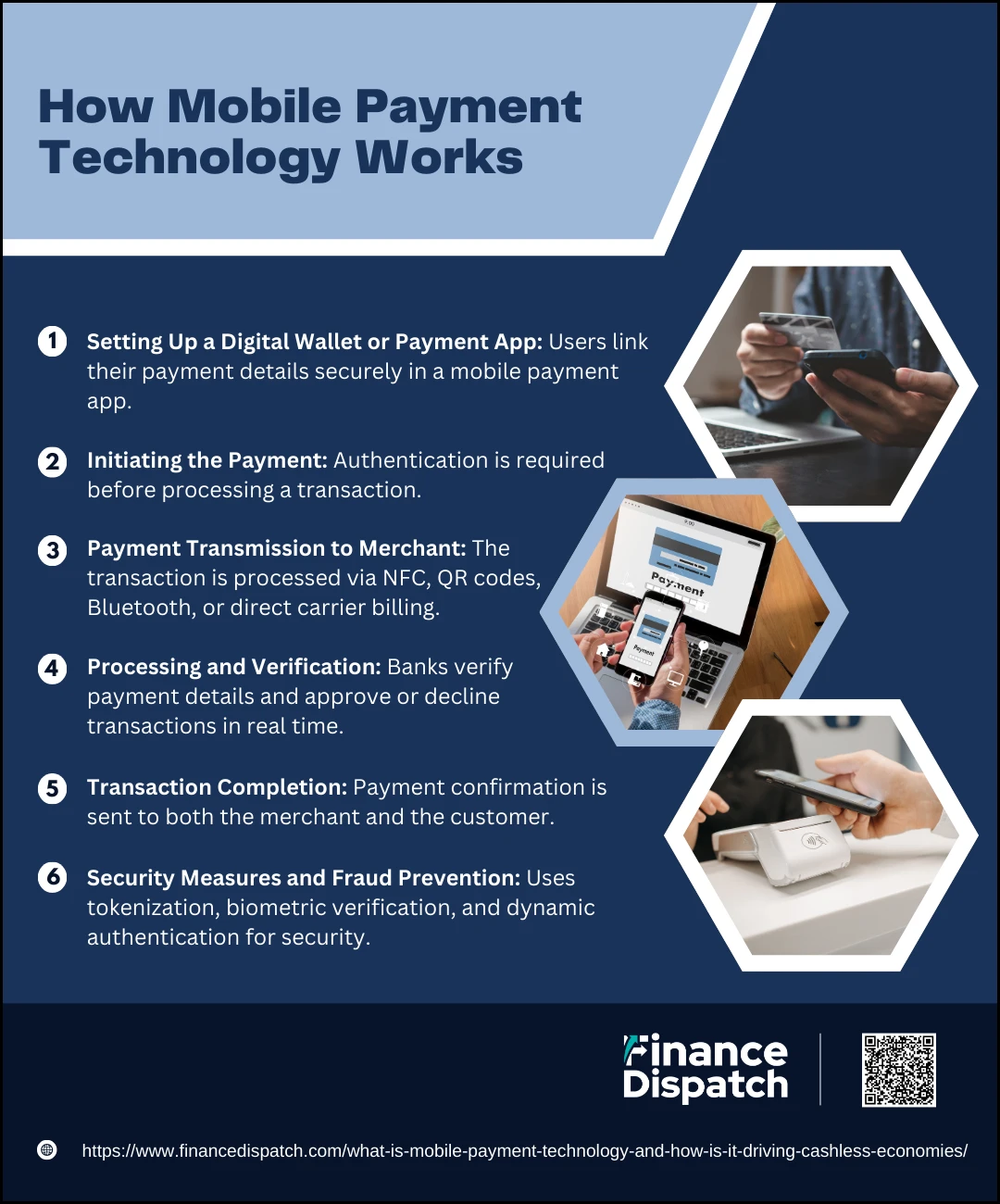 How Mobile Payment Technology Works
How Mobile Payment Technology Works
Mobile payment technology enables fast, secure, and seamless transactions using smartphones, tablets, or other mobile devices. Instead of relying on cash or physical cards, users can tap, scan, or transfer funds digitally through methods such as NFC (Near-Field Communication), QR codes, mobile wallets, and banking apps. These transactions use encryption and tokenization to protect sensitive data, ensuring a secure and efficient payment process. Below is a step-by-step breakdown of how mobile payment technology works.
1. Setting Up a Digital Wallet or Payment App
Users download a mobile payment app (e.g., Apple Pay, Google Pay, PayPal) and securely link their credit card, debit card, or bank account to the app. The payment details are stored securely using tokenization, replacing sensitive financial data with encrypted tokens.
2. Initiating the Payment
To make a payment, the user selects the preferred payment method in the app and authenticates the transaction using a PIN, fingerprint, facial recognition, or passcode. This step ensures security and prevents unauthorized transactions.
3. Payment Transmission to Merchant
The transaction is processed based on the payment method:
- NFC Payments: The user taps their device near an NFC-enabled POS terminal.
- QR Code Payments: The user scans a merchant’s QR code or displays a QR code for the merchant to scan.
- Bluetooth/Beacon Payments: The system detects the user’s device and automatically processes the payment.
- Direct Carrier Billing: The purchase amount is added to the user’s mobile carrier bill.
4. Processing and Verification
The payment data is sent to the merchant’s POS system, which forwards it to a payment processor or acquiring bank. The bank verifies the payment details, checks for sufficient funds, and approves or declines the transaction in real time.
5. Transaction Completion
Once approved, the payment processor sends an authorization code to the merchant, confirming the successful transaction. The customer receives a payment confirmation via notification, email, or SMS, and the transaction is recorded in their payment history.
6. Security Measures and Fraud Prevention
To enhance security, mobile payment systems use:
- Tokenization – Encrypts financial data to prevent fraud.
- Dynamic Authentication – Generates one-time passcodes for each transaction.
- Biometric Verification – Uses facial recognition or fingerprints for secure access.
Why Mobile Payment Technology is Growing Rapidly
Mobile payment technology is experiencing rapid growth due to its convenience, security, and global digital transformation. The widespread adoption of smartphones and internet access has made mobile payments more accessible, allowing users to conduct transactions effortlessly without cash or physical cards. Additionally, advancements in NFC (Near-Field Communication), QR codes, biometric authentication, and tokenization have enhanced security, reducing fraud risks and increasing consumer trust. The COVID-19 pandemic further accelerated this shift as contactless payments became a necessity to minimize physical interactions. Businesses are also embracing mobile payments to streamline transactions, lower costs, and enhance customer experiences. Moreover, mobile payment solutions are driving financial inclusion, providing banking access to unbanked populations in developing regions. As e-commerce, fintech innovations, and digital banking continue to evolve, mobile payments are set to become the dominant mode of financial transactions worldwide.
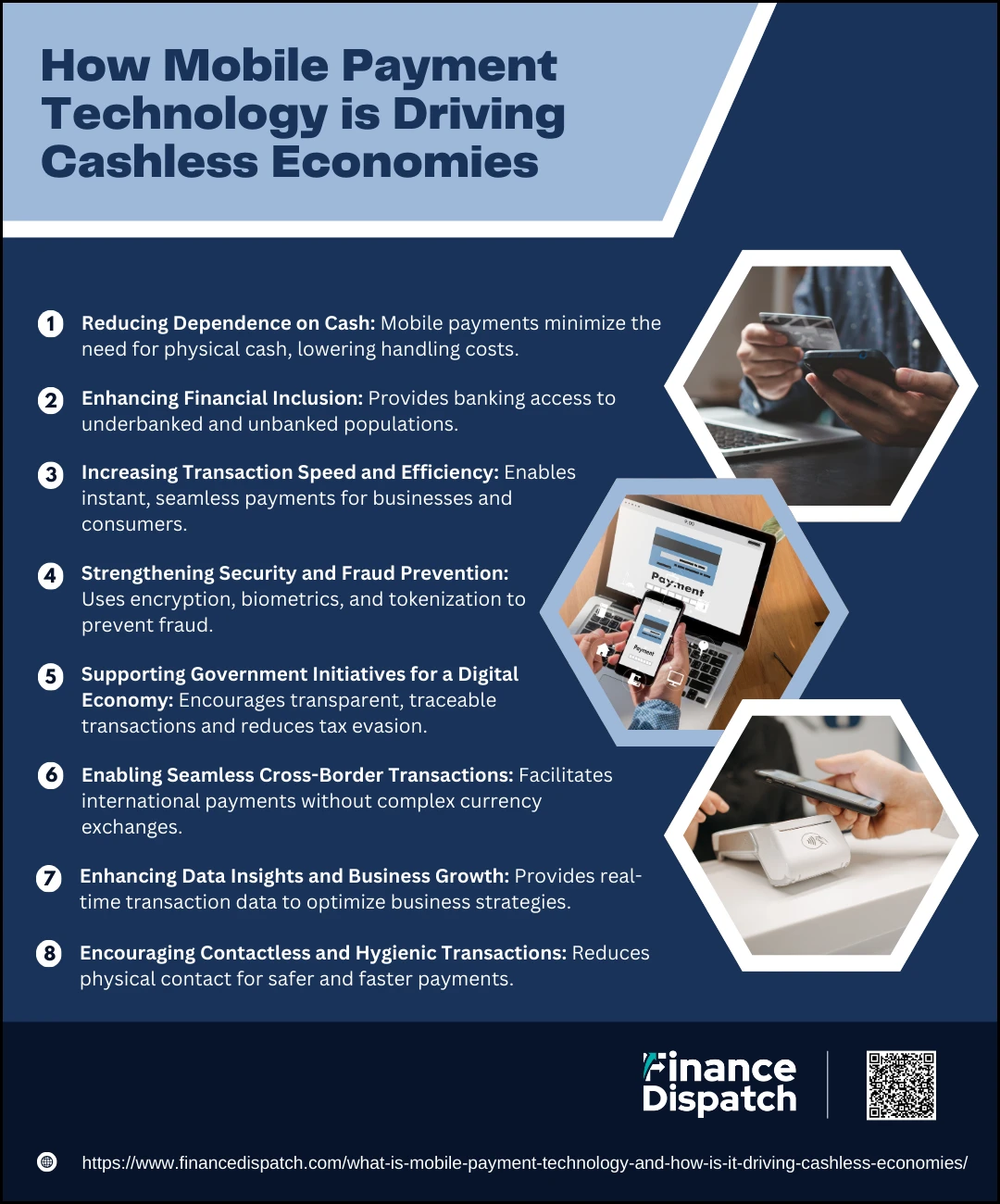 How Mobile Payment Technology is Driving Cashless Economies
How Mobile Payment Technology is Driving Cashless Economies
The shift toward a cashless economy is accelerating, driven by the widespread adoption of mobile payment technology. Digital transactions powered by NFC, QR codes, digital wallets, and mobile banking apps have made payments faster, safer, and more convenient than traditional cash-based systems. Countries like Sweden, China, and India are leading this transformation, where mobile payments dominate everyday transactions. By reducing the reliance on cash, mobile payment technology is fostering financial inclusion, boosting economic efficiency, and enhancing security in global commerce. Below are the key ways mobile payment technology is driving the transition to a cashless economy.
1. Reducing Dependence on Cash
With mobile wallets and contactless payments, people no longer need to carry physical cash, reducing the demand for paper money and coins. This transition minimizes cash-handling costs for businesses and governments.
2. Enhancing Financial Inclusion
Mobile payment technology enables access to banking and financial services for underbanked and unbanked populations. Mobile wallets and digital payment apps allow individuals to store money, transfer funds, and make purchases without needing a traditional bank account.
3. Increasing Transaction Speed and Efficiency
Unlike cash transactions, which require counting and handling, mobile payments are instant and seamless. Whether in stores, online, or peer-to-peer, digital payments enhance business efficiency and consumer convenience.
4. Strengthening Security and Fraud Prevention
Mobile payments use tokenization, encryption, and biometric authentication (fingerprint or facial recognition) to enhance transaction security. These measures reduce fraud risks compared to carrying cash or using physical cards.
5. Supporting Government Initiatives for a Digital Economy
Many governments encourage mobile payments to promote transparent and traceable transactions, reducing tax evasion and corruption. Countries like India have introduced digital payment incentives to drive cashless adoption.
6. Enabling Seamless Cross-Border Transactions
Mobile payment solutions facilitate international transactions without the complexities of currency exchange. Platforms like PayPal, Alipay, and cryptocurrency-based payments are making global commerce more accessible.
7. Enhancing Data Insights and Business Growth
Businesses using mobile payment systems gain access to real-time transaction data, helping them understand customer behavior and optimize marketing strategies. This drives personalized offers, loyalty programs, and better financial management.
8. Encouraging Contactless and Hygienic Transactions
The COVID-19 pandemic reinforced the importance of contactless payments to reduce physical contact. Mobile payments ensure a safer, faster, and touch-free transaction experience in retail, restaurants, and transportation.
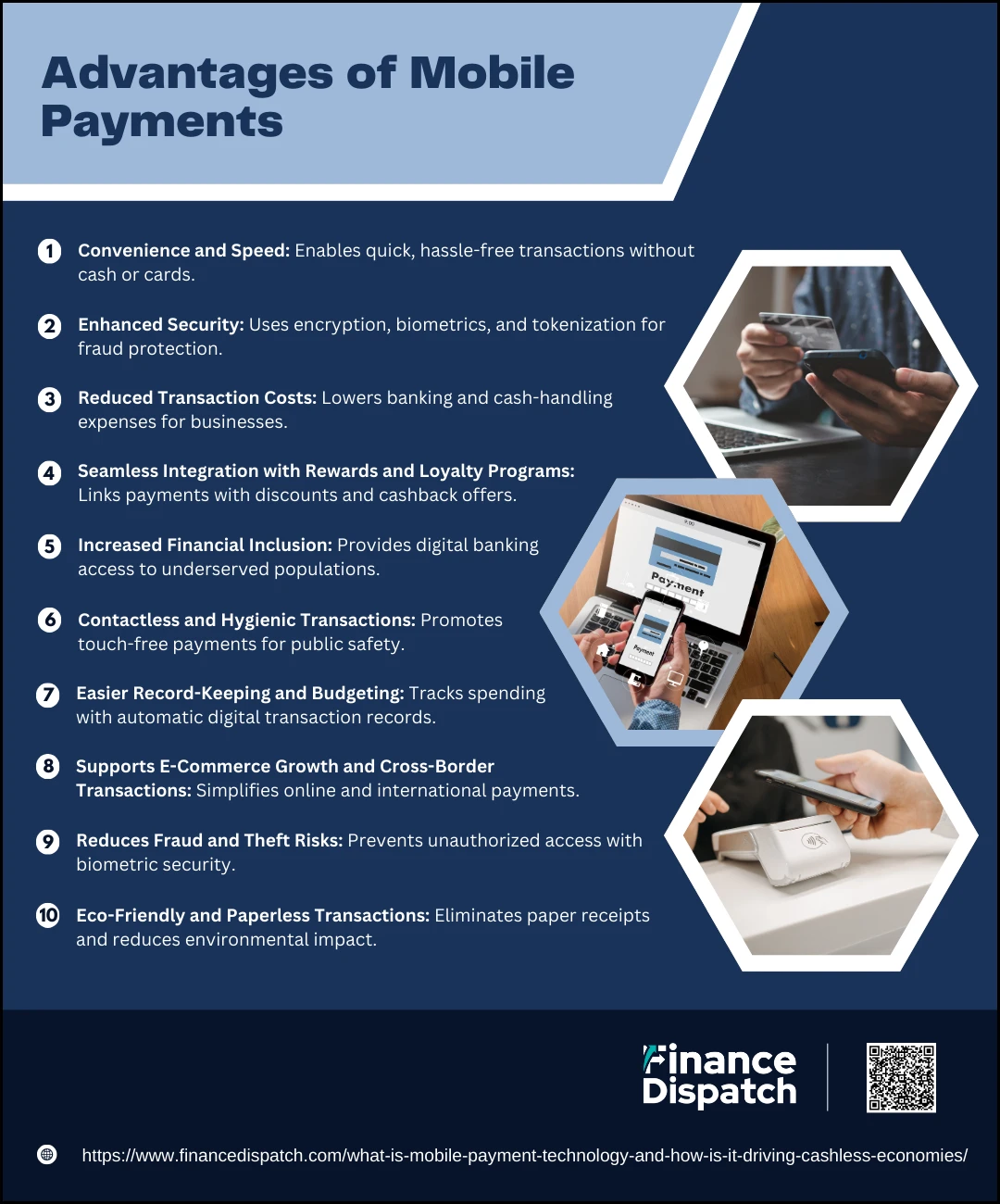 Advantages of Mobile Payments
Advantages of Mobile Payments
Mobile payments have transformed the way people and businesses handle transactions by offering a fast, secure, and convenient alternative to cash and traditional card payments. With the rise of digital wallets, NFC technology, QR codes, and mobile banking apps, consumers can now pay for goods and services with just a tap or scan. This technology not only enhances efficiency and security but also promotes financial inclusion and economic growth. Below are the key advantages of mobile payments.
1. Convenience and Speed
Mobile payments eliminate the need for carrying cash or physical cards, allowing users to complete transactions instantly. Whether shopping in-store, online, or paying bills, mobile payments save time and enhance the overall customer experience.
2. Enhanced Security
With tokenization, encryption, and biometric authentication (fingerprint or facial recognition), mobile payments offer a higher level of security than traditional payment methods. These measures protect sensitive financial information and reduce fraud risks.
3. Reduced Transaction Costs
Mobile payments minimize cash-handling expenses for businesses and reduce reliance on physical banking infrastructure. Digital transactions also lower costs associated with credit card processing fees and ATM withdrawals.
4. Seamless Integration with Rewards and Loyalty Programs
Many mobile payment apps are integrated with loyalty programs and digital coupons, allowing users to earn cashback, discounts, or reward points automatically upon purchase. This encourages customer engagement and repeat business.
5. Increased Financial Inclusion
Mobile payments bridge the gap for unbanked and underbanked populations, especially in developing countries. With just a smartphone, users can access digital banking services, send money, and make purchases, even without a traditional bank account.
6. Contactless and Hygienic Transactions
The COVID-19 pandemic highlighted the need for contactless payment solutions. Mobile payments reduce physical contact with cash, cards, or terminals, making transactions safer and more hygienic in public spaces.
7. Easier Record-Keeping and Budgeting
Every mobile payment transaction is automatically recorded, providing users with detailed expense tracking and budgeting tools through their mobile banking or wallet apps. This helps in better financial planning and management.
8. Supports E-Commerce Growth and Cross-Border Transactions
Mobile payments facilitate online shopping and international transactions with seamless currency conversion and quick payment processing. This enhances global trade and makes digital commerce more accessible.
9. Reduces Fraud and Theft Risks
Unlike carrying cash, which can be lost or stolen, mobile payments ensure that transactions remain secure and traceable. Even if a device is lost, security features like password protection and remote locking prevent unauthorized access.
10. Eco-Friendly and Paperless Transactions
By replacing physical receipts and paper-based billing with digital confirmations, mobile payments contribute to a more sustainable and environmentally friendly financial ecosystem.
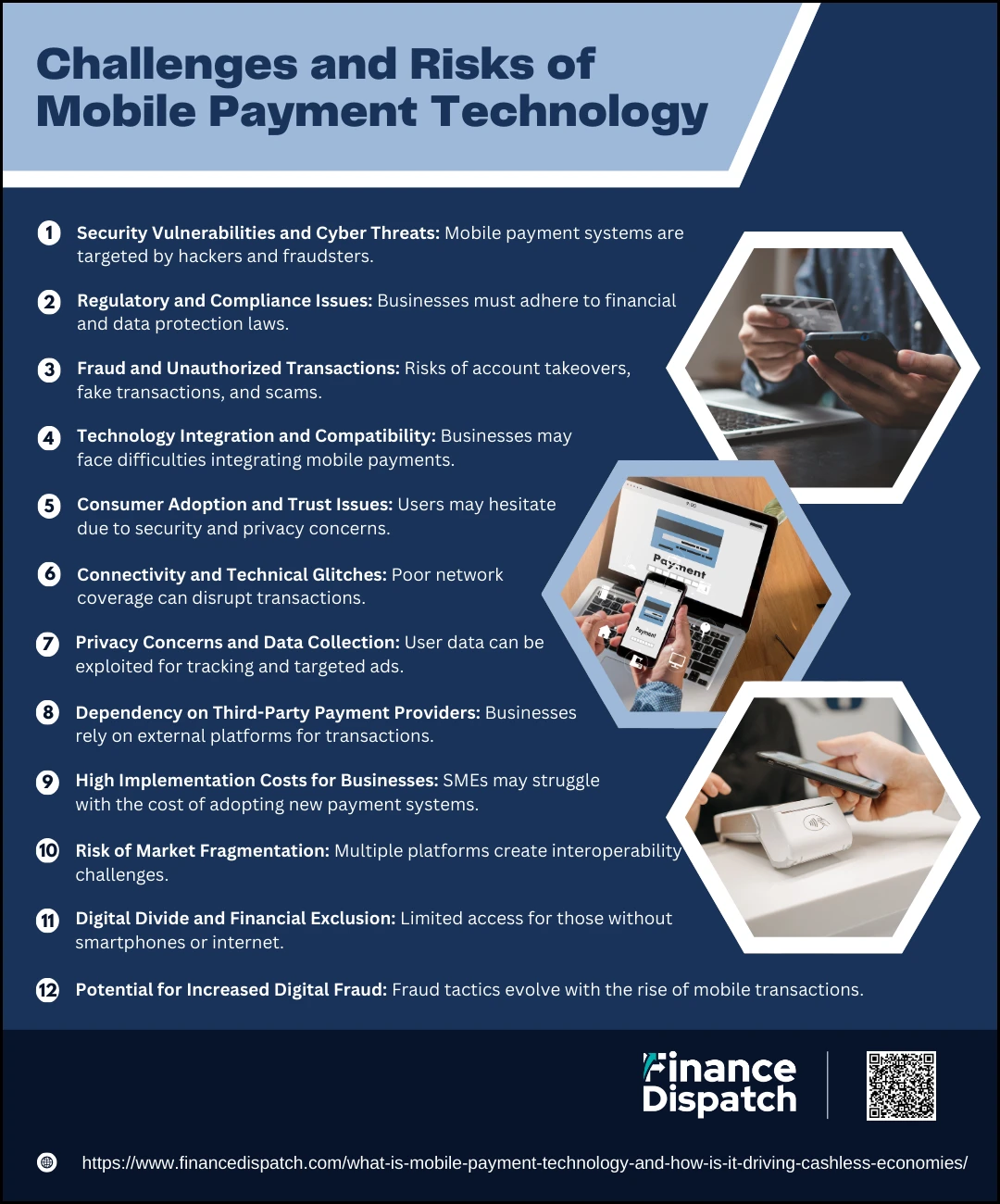 Challenges and Risks of Mobile Payment Technology
Challenges and Risks of Mobile Payment Technology
While mobile payment technology has revolutionized the way people conduct transactions, it also comes with challenges and risks that businesses and consumers must navigate. Issues like security vulnerabilities, regulatory compliance, fraud risks, and technology dependency can hinder the widespread adoption of mobile payments. As digital transactions become more prevalent, it is essential to address these concerns to ensure a safe and efficient payment ecosystem. Below are some of the key challenges and risks associated with mobile payment technology.
1. Security Vulnerabilities and Cyber Threats
Hackers constantly target mobile payment systems with phishing attacks, malware, and data breaches. If not properly secured, sensitive financial information can be stolen or compromised, leading to identity theft and fraudulent transactions.
2. Regulatory and Compliance Issues
Mobile payments are subject to various financial regulations and data protection laws, which differ by country. Businesses must ensure compliance with standards like PCI DSS, GDPR, and anti-money laundering (AML) laws to avoid legal penalties.
3. Fraud and Unauthorized Transactions
Despite security measures, account takeovers, fake transactions, and payment scams remain a concern. Fraudsters may use stolen credentials, social engineering, or fake payment links to manipulate users into making unauthorized transactions.
4. Technology Integration and Compatibility
Many businesses face challenges in integrating mobile payment solutions with their existing POS systems, financial management software, and banking platforms. Older systems may not support newer mobile payment technologies, requiring costly upgrades.
5. Consumer Adoption and Trust Issues
Some users are hesitant to adopt mobile payments due to concerns about security, privacy, or lack of familiarity with the technology. Businesses must educate customers and ensure a seamless user experience to encourage wider adoption.
6. Connectivity and Technical Glitches
Mobile payments depend on internet connectivity and server reliability. Poor network coverage, technical failures, or app crashes can disrupt transactions, leading to frustration for both businesses and consumers.
7. Privacy Concerns and Data Collection
Mobile payment providers collect vast amounts of user data, including transaction history, location, and personal details. If mishandled, this data can be exploited for targeted ads, surveillance, or unauthorized tracking, raising privacy concerns.
8. Dependency on Third-Party Payment Providers
Businesses that rely on mobile payment gateways like Apple Pay, Google Pay, or PayPal are vulnerable to policy changes, service outages, and fee fluctuations. Any disruptions from these providers can impact business operations.
9. High Implementation Costs for Businesses
Small and medium-sized enterprises (SMEs) may struggle with the initial costs of adopting mobile payment technology, including POS upgrades, staff training, and transaction fees, which can reduce profit margins.
10. Risk of Market Fragmentation
With multiple mobile payment platforms and standards in use worldwide, interoperability issues arise. Consumers may face difficulties using certain payment methods across different countries, devices, or merchant networks.
11. Digital Divide and Financial Exclusion
While mobile payments offer convenience, they can exclude populations without smartphones, internet access, or digital literacy. Rural areas and lower-income groups may struggle to access and use mobile payment solutions effectively.
12. Potential for Increased Digital Fraud
As mobile payments grow, so do sophisticated fraud techniques, including deepfake identity fraud, card cloning, and social engineering attacks. Businesses and consumers must remain vigilant and adopt multi-layered security measures.
Future Trends in Mobile Payments
The future of mobile payments is set to be shaped by rapid technological advancements, evolving consumer behavior, and increasing global adoption of digital transactions. Biometric authentication, including fingerprint and facial recognition, will enhance security and convenience, reducing fraud risks while ensuring seamless transactions. The integration of Artificial Intelligence (AI) and Machine Learning (ML) will enable predictive analytics for fraud detection, personalized payment experiences, and real-time financial insights. Additionally, the rise of cryptocurrency and blockchain technology is expected to introduce more secure, decentralized payment solutions, reducing reliance on traditional financial institutions. Central Bank Digital Currencies (CBDCs) are also gaining momentum, with governments exploring digital currencies to facilitate faster, regulated transactions. Furthermore, wearable payment technology, such as smartwatches and fitness bands with built-in payment capabilities, will make contactless transactions even more accessible. As 5G networks expand, mobile payments will become faster and more reliable, driving global adoption. With these innovations, mobile payments are set to become more secure, efficient, and inclusive, paving the way for a fully digital and cashless economy.
Conclusion
Mobile payment technology has revolutionized the way people transact, offering speed, security, and convenience while driving the shift toward cashless economies. As businesses and consumers increasingly adopt contactless payments, digital wallets, and mobile banking, traditional cash transactions continue to decline. While mobile payments provide numerous benefits, challenges such as security risks, regulatory compliance, and technological integration must be addressed to ensure a seamless and secure payment experience. The future of mobile payments will be shaped by biometric authentication, AI-driven security, blockchain technology, and wearable payment solutions, making digital transactions even more accessible and efficient. As innovation continues to evolve, mobile payments will play a central role in global financial ecosystems, transforming the way people manage money and conduct business in an increasingly digital world.



